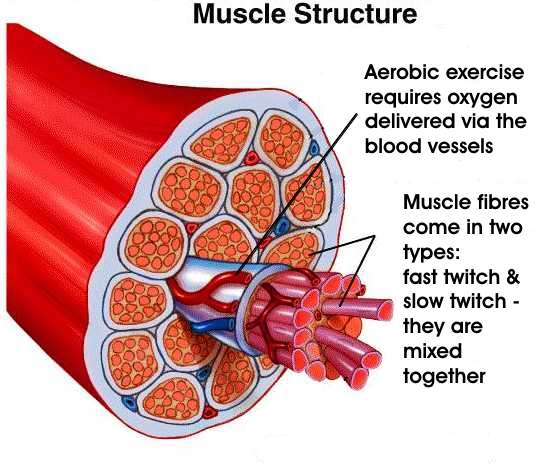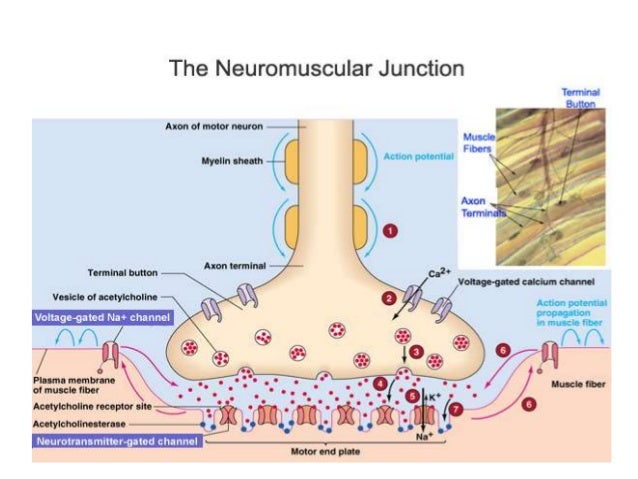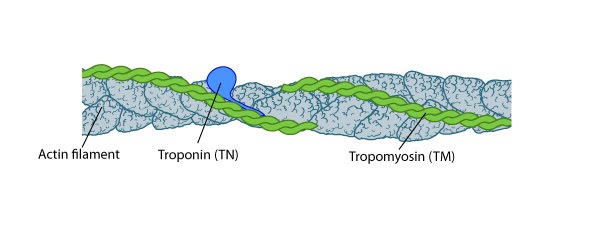Unit 6: Organisms respond to changes in their environment
0.0 / 5
- Created by: Chloe Inglis
- Created on: 09-03-17 11:10
Muscles
- effector organs
- respond to nervous stimulation
- movement
e.g.
- cardiac muscle - heart
- smooth muscle - walls of blood vessels + gut
- involuntary contractions
BUT...
- skeletal muscle - bulk of body muscle
- attached to bone
- voluntary + conscious control of contractions
1 of 30
Structure of skeletal muscle
- myofibrils - tiny muscle fibres that make up muscles
- maximum strength and efficiency
- cells fuse together to form muscle fibres (bundles)
- bundles of fibres make up whole muscle
Muscle Fibres:
- share nuclei + cytoplasm = sarcoplasm
- sarcoplasm - around muscle fibre
- lots of mitochondria + ER
2 of 30
Microscopic structure of myofibrils
Myofibrils are made up of two protein filaments:
- actin - thinner + two intertwining strands
- myosin - thicker + long rod shaped cells + projecting bulbous heads
3 of 30
Microscopic structure of skeletal muscle
- light and dark coloured bands - striations
- I bands (isotropic) - light bands = no overlap of myosin + actin
- A bands (anisotropic) - dark bands = overlap of myosin + actin
- H - zone = centre of each A band
- Z - line = centre of each I band
- Sarcomere = distance between adjacent Z-lines
- Parallel to each other in muscle = force in one direction
- Muscle contractions - sarcomere shortens
- Different pattern of light (I) bands and dark (a) bands
- Tropomyosin - protein - forms fibrous strand around actin
4 of 30
Diagrams of a sarcomere - muscle contraction
5 of 30
Diagram of a sarcomere
6 of 30
Types of muscle fibre
- two types - fast twitch + slow twitch
- variation - type of muscle + person

7 of 30
Slow Twitch Fibres
- slower
- less powerful
- longer
- endurance, e.g. long distance running
- e.g. calf muscles - constantly contracts - keep upright
- AEROBIC RESPIRATION - no build up of lactic acid
- more effective
- shorter contractions
- lots of myoglobin - red - lots of oxygen
- lots of blood vessels - oxygen + glucose - respiration
- mitochondria - ATP
8 of 30
Fast Twitch Fibres
- more rapid
- powerful
- shorter
- intense exercise, e.g. weight lifting
- e.g. biceps muscle - short bursts
- thicker + more myosin filaments
- lots of glycogen
- lots of enzymes - ANAEROBIC RESPIRATION
- rapid production of ATP
- PHOSPHOCREATINE - rapid production of ATP
- ADP + Pi -> ATP
- energy for muscle contraction
9 of 30
Neuromuscular Junctions
- motor neurone meets skeletal muscle fibre
- lots of junctions along muscle
- shorter time for wave of contraction to cross muscle
- simultaneous contraction
- rapid + powerful
- essential for survival
- stimulated by action potential
- muscle fibres - 1 motor neurone - motor unit
- controls force muscle exerts
- weak force = fewer motor units stimulated
- strong force = many motor units stimulated
10 of 30
Diagram of neuromuscular junction

11 of 30
Diagram 2: Neuromuscular Junction

12 of 30
Nerve Impulse at Neuromuscular Junction
- reaches synaptic knob
- synaptic vesicles fuse with presynaptic membrane
- releases acetylcholine into synaptic cleft
- attaches to receptor sites on postsynaptic membrane = membrane of muscle fibre
- alters permeability to Na+ ions - enter rapidly = DEPOLARISATION
- neurotransmitter = acetylcholine
- broken down by acetylcholinerase
- muscle isn't over-stimulated
- choline + ethanoic (acetyl) acid diffuses back into neurone
- recombine to form acetylcholine
- energy (ATP) supplied by mitochondria
13 of 30
Transmission Electron Microscopy (TEM) of skeletal

14 of 30
Neuromuscular Junction vs. Cholonergic Synapse
Similarities:
- neurotransmitters are transported by diffusion
- receptors - bind with neurotransmitter - influx of Na+
- use Na+/K+ pump to repolarise axon
- enzymes break down neurotransmitter
15 of 30
Neuromuscular Junction vs. Cholonergic Synapse
Differences:
Neuromuscular Junction
- excitatory
- neurones link to muscles
- motor neurones
- end of action potential
- acetylcholine binds to receptors on membrane of muscle fibre
Cholinergic Synapse
- excitatory or inhibitory
- neurones link to neurones or effectors
- motor, sensory or intermediate (relay) neurones
- new action potential - postsynaptic membrane
- acetylcholine binds to receptors on postsynaptic membrane
16 of 30
Contraction of skeletal muscle
- movement
- muscles attached to skeleton
- incompressible bone skeleton
- muscle exerts force - bones move around joints
- the muscle does not change shape
- move part of skeleton
- one muscle can't move part in opposite directions
- another muscle = ANTAGONISTIC PAIR
- pull in opposite directions
- one contracts + one relaxes
17 of 30
Sliding filament mechanism
- contraction of muscle fibre
- actin + myosin filaments slide past one another
- muscle function depends on shape of proteins
18 of 30
Evidence for the sliding filament mechanism
- more overlap of actin + myosin during contraction
Changes to sarcomere:
- I-band narrows
- Z-lines are closer together = shorter sarcomere
- H-zone narrows
- A-band stays the same width - length of myosin
- muscle contraction not due to shorter filaments
19 of 30
Myosin
2 proteins:
- fibrous protein - filament - made up of lots of molecules (tail)
- globular protein - two bulbous structures (head)
20 of 30
Actin
- globular protein
- molecules in long + twisted chains
- helical strand
TROPOMYOSIN
- long + thin threads
- wound around actin filaments

21 of 30
The sliding filament mechanism of muscle contracti
- actin + myosin filaments slide past each other
- changes in band patterns on myofibrils
- bulbous heads of myosin form cross bridges with actin
- attach to binding sites on actin
- flex in unison - pull actin filaments along myosin filaments
- ATP - source of energy
- detach - return to original angle
- re-attach further along the actin
- continuous process
22 of 30
Muscle Stimulation
- action potential reaches many neuromuscular junctions simultaneously
- Ca2+ ion protein channels open
- Ca2+ ion diffuse into synaptic knob
- synaptic vesicles fuse with presynaptic membrane
- release acetylcholine (neurotransmitter) into synaptic cleft
- acetylcholine diffuses across synaptic cleft
- binds with receptors on the muscle cell-surface membrane
- DEPOLARISATION
23 of 30
Muscle Contraction
WAVE OF EXCITATION
- action potential travels into fibre
- via tubules (T-tubules) - extensions of cell-surface membrane
- in cyctoplasm of muscle - sarcoplasm
- tubules - ER of muscle = sarcoplasmic reticulum
- active transport of Ca2+ ion from cytoplasm - low concentration
- Ca2+ protein channels open
- Ca2+ diffuse into muscle cytoplasm
- down concentration gradient
- Ca2+ ions cause tropomyosin to pull away
- Ca2+ ions change tertiary structure of tropomyosin - protein!
- bindings site are no longer blocked
24 of 30
Muscle Contraction (cont.)
- ADP attach to myosin head
- binds to actin + forms a cross bridge
- attached to actin - myosin heads change angle
- pulls actin along - releases ADP
- ATP attaches to each myosin head
- myosin heads detach from actin
- Ca2+ ions activate ATPase - forms ADP + Pi via hydrolysis
- provides energy for myosin to return to its original position
- myosin head + ADP - reattaches further along actin
- cyclical process - needs a high concentration of Ca2+ in the myofibril
25 of 30
Diagram of Muscle Contraction

26 of 30
Muscle Contraction (cont.)
- myosin are joined tail to tail
- move in opposite directions
- actin moves in opposite directions
- actin filaments move towards each other
- shorter distance between Z-lines
- movement
27 of 30
Muscle Relaxation
- no nervous stimulation
- Ca2+ actively transported into endoplasmic reticulum
- energy - hydrolysis of ATP to ADP + Pi
- reabsorption of Ca2+ - tropomyosin moves back
- binding sites are blocked again
- myosin heads can't bind to actin
- no muscle contraction
- muscle relaxes
- force from antagonistic muscles pulls actin out from between myosin
28 of 30
Energy supply during muscle contraction
- needs lots of energy
- hydrolysis of ATP to ADP + Pi
- movement of myosin heads
- reabsorption of Ca2+ ions into endoplasmic reticulum by active transport
- escape from danger - rapid response - life-saving
- most ATP is regenerated - respiration of pyruvate in mitochondria
- lots of mitochondria in muscle
29 of 30
Role of Phosphocreatine
ENERGY SUPPLY
- demand for oxygen is greater than the rate of its supply
- need for anaerobic respiration
- PHOSPHOCREATINE + glycolysis
- can't supply energy directly
- regenerates ATP
- stored in muscle
- reserve supply of phosphate
- ADP + Pi -> ATP
- muscle relaxes - store of phosphocreatine is replenished - Pi from ATP
30 of 30
Related discussions on The Student Room
- AQA A-Level Biology Paper 3 [21st June 2023] Exam Chat »
- Is a myofibril an organelle »
- In AQA Triple Biology P 2 is kidneys,anatomy,nephrons and etc a topic we need to do? »
- Paper 3 AQA a Level biology »
- Btech results »
- Paper 3 essay?? (aqa) »
- Kinesis - help »
- No results (gym) »
- 5 ways how AI is improving cloud computing »
- AQA GCSE Biology Paper 2 Higher Tier [9th June 2023] »
Similar Biology resources:
0.0 / 5
0.0 / 5
1.0 / 5 based on 1 rating
0.0 / 5
0.0 / 5
0.0 / 5
0.0 / 5
Comments
No comments have yet been made